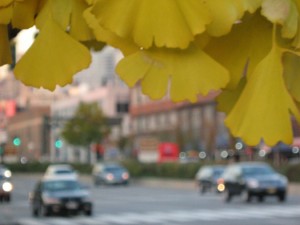You discover many fascinating things here on the A Life’s Work blog, like what’s the filmmaker’s favorite tree. And today? What’s the filmmaker’s second favorite tree.
… ginkgo [or maidenhair tree], often seen in big-city streets, as it has a constitution to survive the dangers there: polluted air, desert aridity of pavements, salt used to melt ice on sidewalks, and visits of male dogs. Fan-shaped leaves resemble the fronds of maidenhair fern. This is one of the two trees that have survived to our day from the Coal Age. (The other is cycad, which is halfway between a fern and a palm.) Pollen of the maidenhair tree is like the swimming spores of ferns. Instead of being carried by winds or insects, like the pollen of other trees, it must swim to the female flowers through rain or dew.
It is as though the maidenhair tree had been delivered to us by parcel post from the early Mesozoic Era, 120 million years ago. It had the narrowest escape from extinction, surviving only at a remote sanctuary in western China, where it had been tended by monks for generations as a temple decoration. Neither a fern, a pine tree, nor a hardwood — it is a combination of all three.
From 1001 Questions Answered About Trees, by Rutherford Platt, Dover Publications.
Goethe wrote a beautiful poem using the ginkgo as its central image. The link will take you to an image of the manuscript (he pasted ginkgo leaves to it and gave it to an ex-lover) and translations of the poem in several languages, including English.
What’s your favorite tree? What’s your second favorite tree?
